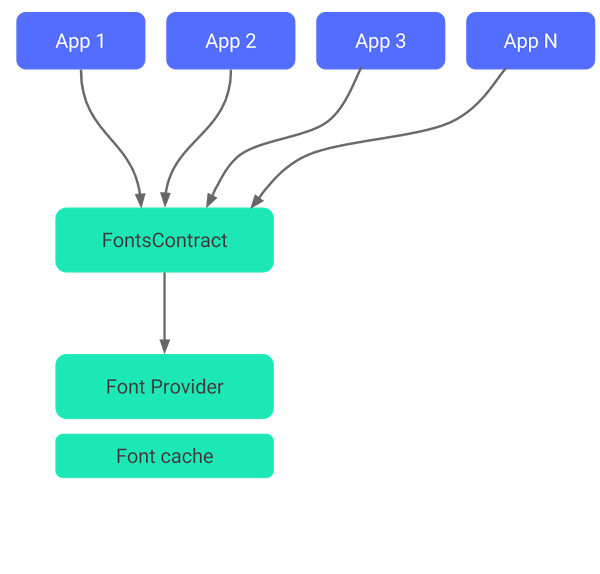Design a site like this with WordPress.com
Android Nuggets 8: Fonts

Date: 31st Jul 2021
Author: karandeepmalik
A computer font is a great demonstration of arts and aesthetics combined seamless with technology. Fonts can be bitmap or vector fonts. Most fonts that are used nowadays are vector fonts. These fonts even on scaling retain their shape and curvature. The shape of each glyph in such a font is made up of straight and curved lines. Vector fonts are are made up of pre-defined shapes such as quadratic Bézier curves or cubic Bézier curves. A rasterizer transforms vector (outline) shapes (glyphs) contained in a font file into bitmap images. So, what you seeon screen as text is actually set of bitmap images. The shapes are adapted to a very small number of pixels, finding the best compromise between sharpness, fidelity to the original design, and consistency.
As part of Android, the default font that is provided is Roboto. Since Ice Cream Sandwich, it is the defacto font. Roboto contains characters from Latin Greek and Cyrillic and covers most of the Android user locales. It comes in 18 different variations such as Italic, Normal, Thin, Light, Medium, Bold, Black, Condensed etc. For languages other than the ones covered by Roboto, as part of Google Internationalization effort, a series of Noto Fonts were created. They have same feel and style as Roboto.
Though fonts come in different variations it is quite possible that originally there are only on or two base variations of fonts and for producing different weight and thickness, the base variations undergo mathematical transformations. This is handled by the Minican library layer.
An important issue to deal with, while using font text in TextViews is the ability to break text into line and paragraphs. While for English, this is easier as spaces between words act as natural segue, in other languages that donot have spaces between words, it is required to have knowledge of the language and punctuations in the language and deal with them separately. Since Nougat, Android is using Unicode standard and dictionaries to know line breaks for every locale.
There are three ways in fonts can be provided for use in an app. For apps, the most common way is to bundle the specific font with the app. The bundled fonts can be included as part of res/font and can be used throughout the app by specifying
In xml layouts:
1
2
3
4
<TextView
android:layout_width="wrap_content"
android:layout_height="wrap_content"
android:fontFamily="@font/my_font"/>
Or add fonts to style and apply the style:
1
2
3
<style name="customfontstyle" parent="@android:style/TextAppearance.Small">
<item name="android:fontFamily">@font/helvetica</item>
</style>
or using code
1
2
Typeface tf = ResourcesCompat.getFont(this,R.font.helvetica);
txt.setTypeface(tf);
The second way in shich fonts can be provided is through the Font provider. Such fonts are called downloadable fonts. The Font provider provides fonts through a content provider interface. Google fonts are made available through this mechanism. The advantage using the downloadable fonts is that at install time of app, these fonts are downloaded and kept in a common cache and all apps using this font will refer to the same cache and use fonts from there. For specifying the downloadable fonts, one has to specify an xml which contains the font uri, package and certificates for authentication. The reason certificates need to be provided is because due to the design of font files they allow code to be executed from within and so it is important to verify the provider before downloading fonts.

Using Downloadable fonts through code :-
val request = FontRequest( <font-authority>, <font-package>, <font-name>, <font-certificates> ) val callback = object : FontsContract.FontRequestCallback() { override fun onTypefaceRetrieved(typeface: Typeface) { // Your code to use the font goes here ... } override fun onTypefaceRequestFailed(reason: Int) { // Your code to deal with the failure goes here ... } } FontsContract.requestFonts(context, request, handler, null, callback)
Using downloadable fonts through xml
Create an xml file in res/font
<?xml version="1.0" encoding="utf-8"?> <font-family xmlns:android="http://schemas.android.com/apk/res/android" android:fontProviderAuthority="com.example.fontprovider.authority" android:fontProviderPackage="com.example.fontprovider" android:fontProviderQuery="example font" android:fontProviderCerts="@array/certs"> </font-family>
The third way is the way through which google includes some default fonts with AOSP. These fonts are called system fonts.
Using system fonts through code
TextView lblexample = (TextView) findViewById(R.id.lblexample); lblexample.setTypeface(Typeface.createFromFile("/system/fonts/" + "fontsname" + ".ttf"));
Share this:
Related
